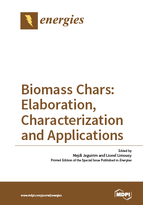Biomass Chars: Elaboration, Characterization and Applications
A special issue of Energies (ISSN 1996-1073).
Deadline for manuscript submissions: closed (30 June 2017) | Viewed by 102611
Special Issue Editors
Interests: biomass valorization: pyrolysis, gasification, and combustion of different biomasses, including agriculture residues and agro-industrial by-products; thermal degradation mechanisms and kinetics; gas emission analysis; exhaust gas treatment: exhaust gas treatment in fixed and mobile sources; NOx and soot abatement; volatile organic compound elimination
Special Issues, Collections and Topics in MDPI journals
Interests: Biomass conversion and valorization; carbon materials; biological and physicochemical wastewater treatments; adsorption of pollutants; chemical engineering and processing; batch and continuous reactors; design synthesis and characterization of carbon adsorbents (chars, activated carbons, composite materials)
Special Issues, Collections and Topics in MDPI journals
Special Issue Information
Dear Colleagues,
Biomass can be converted to energy, biofuels, and, bioproducts, via thermochemical conversion processes, such as combustion, pyrolysis and gasification. Combustion technology is the most widely applied on an industrial scale. However, biomass gasification and pyrolysis processes are still in research and development stage. The major products from these processes are syngas, bio-oil and char (called also biochar for agronomic application). Among these products, biomass chars have received currently an increasing attention for different applications such as gasification, co-combustion, catalysts or adsorbents precursor, soil amendment, carbon fuel cells, supercapacitors.
This Special Issue provides an overview for biomass chars production methods (pyrolysis, hydrothermal carbonization, etc.), the characterization techniques (Scanning Electronic Microscopy, X-Ray Fluorescence, Nitrogen adsorption, Raman Spectroscopy, Nuclear Magnetic Resonance Spectroscopy, X-ray photoelectron spectroscopy, Temperature Programmed Desorption and Mass Spectrometry, etc.), their properties and their suitable recovery processes.
Prof. Mejdi Jeguirim
Prof. Lionel Limousy
Guest Editors
Manuscript Submission Information
Manuscripts should be submitted online at www.mdpi.com by registering and logging in to this website. Once you are registered, click here to go to the submission form. Manuscripts can be submitted until the deadline. All submissions that pass pre-check are peer-reviewed. Accepted papers will be published continuously in the journal (as soon as accepted) and will be listed together on the special issue website. Research articles, review articles as well as short communications are invited. For planned papers, a title and short abstract (about 100 words) can be sent to the Editorial Office for announcement on this website.
Submitted manuscripts should not have been published previously, nor be under consideration for publication elsewhere (except conference proceedings papers). All manuscripts are thoroughly refereed through a single-blind peer-review process. A guide for authors and other relevant information for submission of manuscripts is available on the Instructions for Authors page. Energies is an international peer-reviewed open access semimonthly journal published by MDPI.
Please visit the Instructions for Authors page before submitting a manuscript. The Article Processing Charge (APC) for publication in this open access journal is 2600 CHF (Swiss Francs). Submitted papers should be well formatted and use good English. Authors may use MDPI's English editing service prior to publication or during author revisions.
Keywords
- biomass
- thermochemical conversion
- chars
- morphological
- textural and structural properties
- surface chemistry
- gasification
- soil amendment
- reactivity







